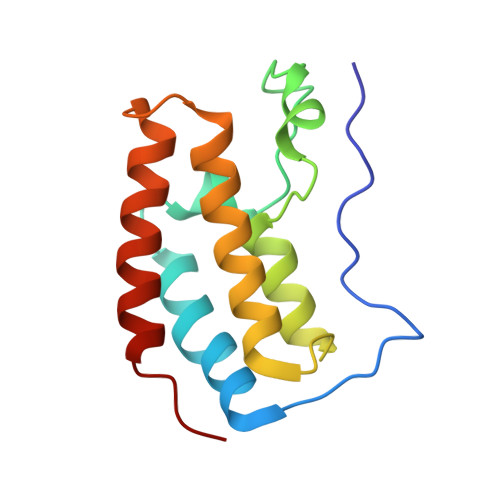Diving into the Water: Inducible Binding Conformations for BRD4, TAF1(2), BRD9, and CECR2 Bromodomains.
Crawford, T.D., Tsui, V., Flynn, E.M., Wang, S., Taylor, A.M., Cote, A., Audia, J.E., Beresini, M.H., Burdick, D.J., Cummings, R., Dakin, L.A., Duplessis, M., Good, A.C., Hewitt, M.C., Huang, H.R., Jayaram, H., Kiefer, J.R., Jiang, Y., Murray, J., Nasveschuk, C.G., Pardo, E., Poy, F., Romero, F.A., Tang, Y., Wang, J., Xu, Z., Zawadzke, L.E., Zhu, X., Albrecht, B.K., Magnuson, S.R., Bellon, S., Cochran, A.G.(2016) J Med Chem 59: 5391-5402
- PubMed: 27219867
- DOI: https://doi.org/10.1021/acs.jmedchem.6b00264
- Primary Citation of Related Structures:
5I1Q, 5I29, 5I40, 5I7X, 5I7Y, 5I80, 5I88 - PubMed Abstract:
The biological role played by non-BET bromodomains remains poorly understood, and it is therefore imperative to identify potent and highly selective inhibitors to effectively explore the biology of individual bromodomain proteins. A ligand-efficient nonselective bromodomain inhibitor was identified from a 6-methyl pyrrolopyridone fragment. Small hydrophobic substituents replacing the N-methyl group were designed directing toward the conserved bromodomain water pocket, and two distinct binding conformations were then observed. The substituents either directly displaced and rearranged the conserved solvent network, as in BRD4(1) and TAF1(2), or induced a narrow hydrophobic channel adjacent to the lipophilic shelf, as in BRD9 and CECR2. The preference of distinct substituents for individual bromodomains provided selectivity handles useful for future lead optimization efforts for selective BRD9, CECR2, and TAF1(2) inhibitors.
Organizational Affiliation:
Genentech, Inc. 1 DNA Way, South San Francisco, California 94080, United States.

















